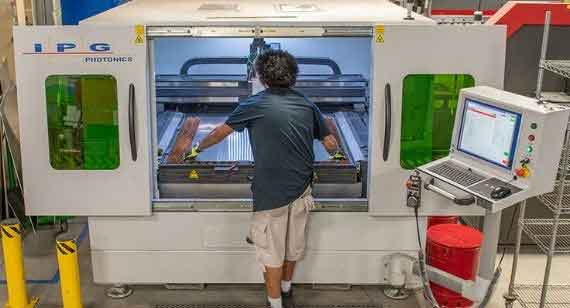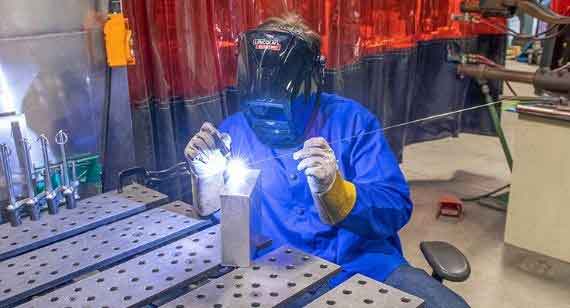Key Sheet Metal Fabrication Costs to Consider

Learning how to create functional designs for your sheet metal parts does take a bit of time (and practice). A large part of this is the understanding of how to maximize part utility and effectiveness while making it as affordable as possible. When designing parts, consider the following sheet metal fabrication cost savings to save on part price without compromising your design intent.
Material Selection for Sheet Metal Fabrication
Common sheet metal materials include aluminum, low-carbon steel, stainless steel, and copper. Each of these material types have properties that shine to support the needs of your part and should be considered in design. However, some materials may require additional processing—such as plating—to ensure longevity and functionality.
When considering which materials to select for your sheet metal project, ask yourself a few key questions:
- What is the purpose of the part? If you are in the prototyping stage or replicating the part for a trade show or other need, you likely don’t need to invest in an exotic material. Finding a more common alloy can do the trick.
- Why are you choosing the particular material? With countless options available for sheet metal fabrication, it’s helpful to know why you are looking for a particular material. Material properties have a major impact on part design, but can also increase sheet metal fabrication costs significantly. Finding a material that meets 80 percent of your required characteristics for your part might help with part price. Does it need to have conductive properties? Will the part be subject to a salt water environment? Are you looking for something that can be powder coated? Determining which of these conditions and properties are the most important will help you select a good candidate for substitution.
- Will the material require a surface treatment? When you select carbon steel you will likely have to invest in additional plating to prevent corrosion and protect the material. If plating is time or cost prohibitive for this project, a pre-plated steel like galvanized or galvanneal may be a good fit. Passivation, on the other hand, is often essential for stainless steel parts to remove surface contaminants and prevent corrosion. When choosing a material, consider surface treatment, as it will increase your part price and lead time.
Welding for Sheet Metal Fabrication
Welding is one of the most common methods for joining or fusing sheet metal and is a critical design feature. However, it can be a drag on price due to the amount of time and training it requires, especially depending on the chosen weld location, type, and part functionality.
Fillet, tack, and stitch welds are the most common types of welds available for sheet metal fabrication. Fillet welds are often pricier because they require a precise, continuous bead that joins two pieces of metal together. If you are working on a prototype part that will have a long fillet weld, you may consider using a stitch weld while you verify your design—it will do what you need (join two pieces together) without such a high price tag. It’s also important to note that extensive fillet welding may have an impact on part design and tolerances due to excessive heat.
| Welding vs. Riveting: Which is Best? |
|---|
|
Welding and riveting both offer advantages and limitations depending on your sheet metal part and available budget for your project. Learn more in our blog post, where we break down the differences between the two to optimize your part design. |
Complex welds can also increase per part metal fabrication cost significantly. Fusing corners together with welding, for instance, could be more cost prohibitive than choosing rivets, which can be just as effective as joining two pieces together.
Welding thinner sheet metal parts (less than 1mm or .039 in. thick) also brings some risk in to the equation, as it can distort the material due to the extreme heat. In this case, riveting can be a more cost-efficient solution, while also ensuring a higher quality sheet metal part in the process. Riveting does have its own cost considerations as well.

Fasteners Can Influence Sheet Metal Part Price
While riveting can often be the more economical choice for your parts, the cost can increase significantly based on hardware selection. From studs and pins to mounts to panel screws, the PEM hardware catalog offers numerous options – including pricier, hard-to-find hardware that can drastically increase your price per part. As you are considering riveting and selecting your hardware, there are a few issues to consider along the way:
- Understand the purpose of the rivets and the value they provide to the part (load-bearing vs. aesthetically pleasing rivets will require a different selection)
- Know what additional services may be required for your hardware selection (chamfering and deburring can increase your sheet metal part price)
- Evaluate what’s needed for assembly (rivets can often simplify assemblies with some insight into the best use case or hardware selection)
In addition, self-clinching fasteners are becoming more popular in for sheet metal hardware and in the right circumstances, they may be the best selection for a more economical and visually appealing part. Self-clinching fasteners become a permanent part of the metal without taking as much space as other hardware, and can make it easier to assemble parts as the installation is completed during the fabrication process. This may reduce overall costs for the part assembly. However, these may not work with every geometry, which is important to consider before making them a requirement for your assembly.
Finishing Options for Sheet Metal
In the design phase of creating a part, it’s exciting to think about what the final product will look like. There are a myriad of finishing options, which can add texture, color, or even protect the metal as it’s used in its application. Popular finishing options may include plating, passivation, powder coating, and silk screening. Each of these can present some essential cost trade-offs in your design:
- Plating: As mentioned earlier, plating helps prevents corrosion. Most commonly used plating options include anodizing, chromate, zinc, tin, and black oxide. Understanding the benefits of each and selecting one that supports your part purpose can help minimize the cost.
- Passivation: Like plating, passivation helps to prevent corrosion, but is used most commonly with stainless steel parts. Since this is often recommended with stainless steel, make sure you consider this additional cost in your part price.
- Powder coating: Offering a durable hard finish, powder coating can add a textured or non-textured finish in more than 50 colors (including RAL colors). Custom colors can drive up the cost and lead time, so it’s important to evaluate the available colors and see if one of the shades can work with your part specifications.
- Silk screening: Like powder coating, costs can increase if you are opting for a more customized finish with silk screening or creating a complex design (more than one color silk screens, for instance). Take this into consideration to reduce costs on your sheet metal parts.
How China Metal Parts can help
When designing your sheet metal parts, there are numerous things to take into account—especially if you are focused on creating more economical parts for your project budget. Here at China Metal Parts, we offer several solutions to support your needs. Our team of experienced applications engineers can help identify how to maximize part effectiveness with your design, while discussing key cost trade-offs. Often times, with insight into the part use case and overall project design, they can provide recommendations that will help with overall design and part cost.
In addition, when you upload your sheet metal part design to our quoting system, you’ll receive a quote back in hours. Plus, now, if there’s an opportunity to save on metal fabrication costs by improving your design, your quote will include that recommendation and outline how much time and money you will save with our alternative option. In addition, our team is here to talk through the suggested changes and help you finalize your quote so we can get sheet metal parts in your hands in a matter of days.
Ready to get started? Upload your sheet metal part today!

Matt Garrett is the technical operations manager for sheet metal fabrication at China Metal Parts. He has worked for China Metal Parts for 12 years and has served in various leadership roles within estimating and programming. He lives in Allenstown, NH with his wife, 5-year-old son, and 3-year-old daughter, and enjoys cooking, playing guitar, and working on cars.